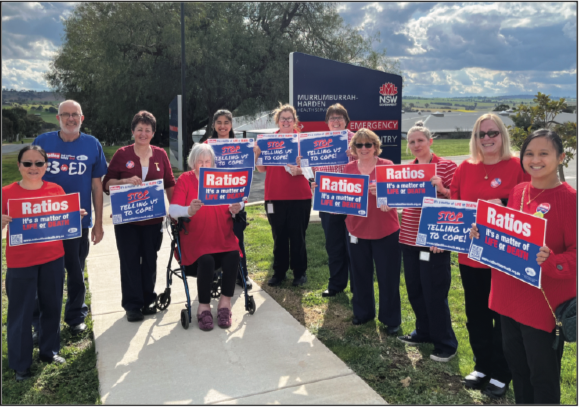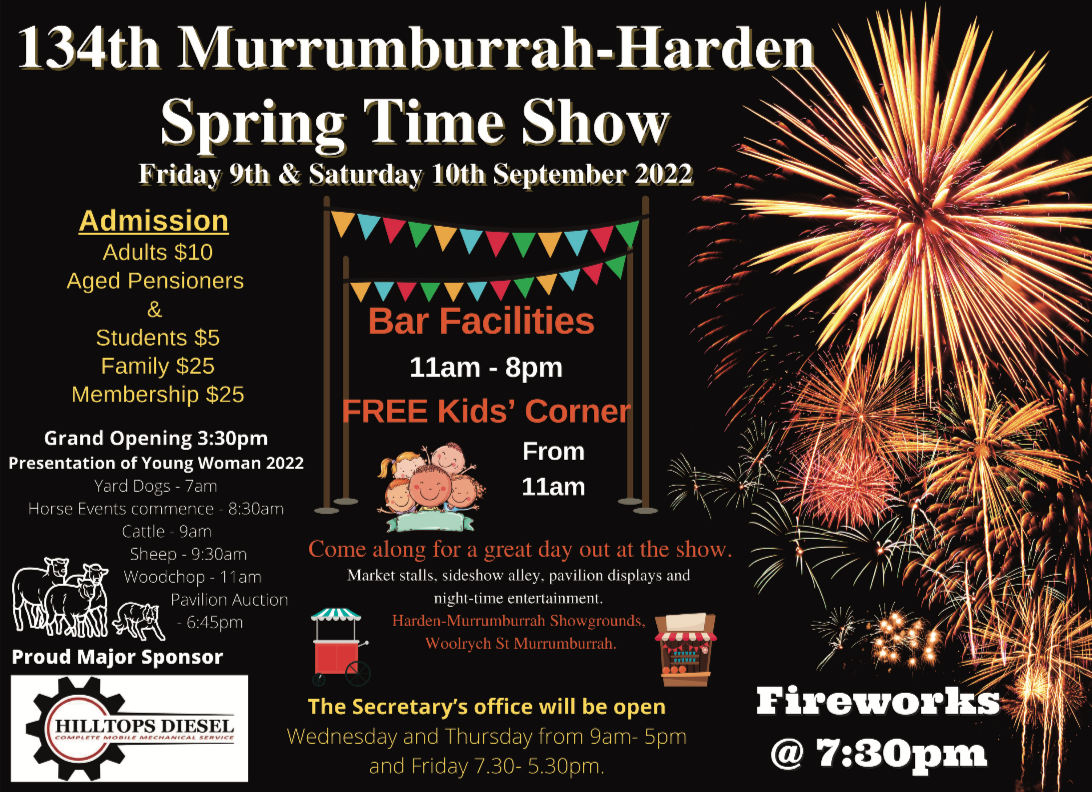Nurses and midwives at Harden Hospital participated in a 24-hour strike on Thursday, 1 September to fight for better staff to patient ratios.
NSW Nurses and Midwives Association (NSWNMA) members across the Riverina participated in the statewide strike and looked to gain community support.
Thousands of nurses and midwives participated in a 24-hour strike, commencing at 7am on Thursday (morning shift) and concluding at 7am on Friday, 2 September.
 Staff at Harden Hospital, along with some residents, left the premises to strike out the front of the building between 2pm and 2:30pm on Thursday.
Staff at Harden Hospital, along with some residents, left the premises to strike out the front of the building between 2pm and 2:30pm on Thursday.
With staffing resources already stretched at Harden Hospital, nurses and midwives are fighting for one nurse to every four patients in the wards and one to three in ED.
Zaida Rufino Secretary of the Union and Dianne Malone President of the Union and enrolled nurse at Harden Hospital said the improved nurse ratios are critical for each patient to receive the best care.
“We need these ratios to make sure that we can look after our patients better. Patients are our main priority. A pay rise would be lovely but our main priority is to get enough staff on the floor to look after people safely,” Malone said.
“We don’t feel like our voices are being heard by the upper bodies in Sydney. They keep on telling us that we’re coping, but we’re not coping.”
Zaida believes there has been no improvements from the Murrumbidgee Local Health District (MLHD) following a number of strike actions already in 2022.
The NSW government says it does not support a review of rural mental health services, nor the establishment of an independent body to investigate alleged cover-ups and medical errors, as recommended by a recent inquiry.
 “There’s been no changes and it’s getting worse.
“There’s been no changes and it’s getting worse.
I’m a registered nurse here and I’m pregnant so I’m not going to be here for much longer,” Zaida said.
“Many other people are also retiring.”
The Harden Hospital currently has got a large number of vacancies that need to be filled.
“We’ve got vacancies in ED. In our acute care we’ve only got two full-time staff members, there’s me who is pregnant and one other.
 Aside from that, we’ve only got casual, agency and a surge nurse who’s working in acute and another in aged care,” Zaida continued.
Aside from that, we’ve only got casual, agency and a surge nurse who’s working in acute and another in aged care,” Zaida continued.
“If I leave, we’ll only have one full-time staff member. It’s very sparse.”
The NSWNMA are currently fighting for a seven per cent pay rise, which was voted on by all 60 of the branches across NSW and was passed by the Union.
“After today’s strike, they’ll go back to the Union and they’ll go back to the State Health Ministers I hope.
Hopefully, it can feel a bit more realistic with our futures, because at the moment there isn’t one,” Dianne said. “I retired two years ago, and I’ve been working casual continually to help the community.
I can’t in good conscience leave because there’s no one to come in and replace me at the moment.
“In the city, they’ve got more capacity to do a strike. Our effort today was to wear red shirts because we don’t have enough staff to go off site at every stage and stop work.
“The 30-minute strike we planned today is for a photo and to go back to work. We have to use our own time during a lunch or morning tea break just for this.
“Most of our beds are full nowadays. We’re just looking for more staff for patient safety.
 They need to have a clean bed to get into.”
They need to have a clean bed to get into.”
The Victorian Government announced last week that they will be making it free to study nursing and midwifery degrees, with Zaida and Dianne in agreeance that it should be implemented in NSW too.
“The local areas are trying to introduce incentives for nurses to finish their degrees and move out to rural areas to work, but we are currently not receiving any here in Harden,” Dianne said. “They are persuading nurses to go from the city to rural areas and receive these incentives.
Western Area Health were offering up to $10,000 for a registered nurse to go to a certain place.
“There are no universities flowing into hospitals out here and it’s a bigger problem because if they move out here they have no accommodation.
“We’re looking for more staff whenever they’re available.”
As part of their fight to achieve safe staffing ratios in every ward, on every shift, in every hospital and health service, NSWNMA members encouraged residents to join one of over 60 community rallies across the state and have a chat about ratios.
NSWNMA General Secretary, Shaye Candish, said the third statewide strike was necessary because of the NSW government’s unwillingness to listen to the concerns of highly skilled clinicians about safe staffing and patient safety.
“We need the NSW government to engage in meaningful discussions on introducing safe nursing and midwifery ratios across our state,” said Ms Candish.
“We all agree the public health system needs widespread improvement and we have put forward a comprehensive solution for many years – we need ratios in NSW.
“What nurses and midwives are seeking is not unreasonable.
The NSW government must prioritise patient care and commit to a safer staffing model with a guaranteed minimum number of nurses and midwives on every shift.
The evidence is clear that ratios save lives and reduce costs.”
During the 24-hour strike, life-preserving services will be maintained in all public hospitals and health services.
Nurses and midwives never take strike action lightly and are advocating for patient safety and better staffing to ensure all communities get the clinical care they deserve.
Tim Warren


